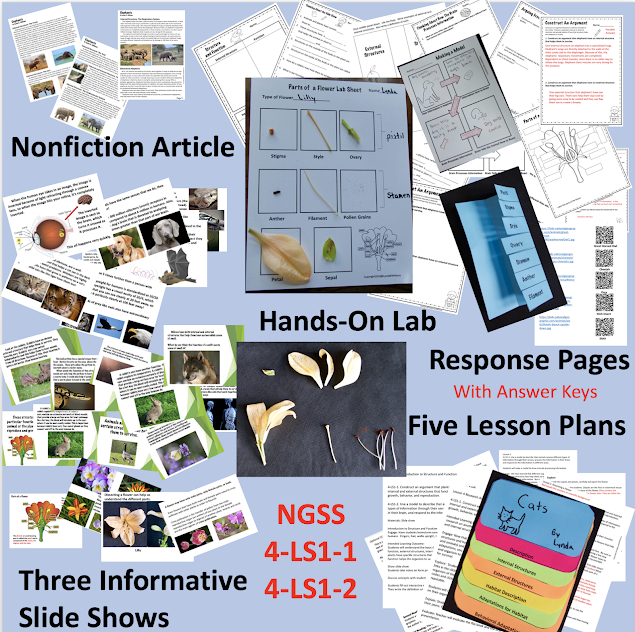Dissecting a Flower to Teach Structure and Function
I decided to write a blog post on how to dissect a flower. Students can learn a lot about the structure and function of different parts of the flower by dissecting one. They can also learn about pollination and pollinators. Dissecting a flower is a great investigation.
Materials:
Florists will often donate browning or
old flowers, which work fine.
Be sure to tell them you are a teacher!
You
can supplement these by purchasing
a few new specimens that clearly show the structure of the flower. The
best flower types to dissect include lilies, tulips, daffodils,
and
gladiolus.
I used a lily in my example. You need a flower for each group of students.
If daylilies are plentiful near you, it is possible to get someone to donate a flower for each student. Daylilies have all the parts we are looking for and the bloom prolifically.
Background Information: Plants have male and female parts. (Teachers just ignore the giggles from the kids. Speak matter of factly about the fact that all living things reproduce and with plants are living things, so they reproduce).
Some plants have exclusively male
parts. Some flowers have exclusively
female parts. More commonly, plants have both male and female parts.
Plants do not move so they need help moving pollen from male parts to
female parts. Even flowers that have
both male and female parts need to cross-pollinate with other plants in order
to flourish.
Cross-pollination is the transfer of pollen from the male reproductive organ (an anther) of one plant to the female
reproductive organ (a stigma) of another plant. Insects and wind are the main agents of cross-pollination.
1. Have the students find the sepals. (Sepals are the first or
outermost tissue you encounter on the stem at the base of the flower. )They protect the flower bud before it
opens and support the flower later. They are often the same color as the petals.
2. Have students identify the petals.
3. have the students locate the stamen and the pistil.
Have them first look closely at the stamen. It is made up of two parts: The filament and the anther. The anther has the pollen. Your students may notice that their flower has more male parts than female parts. Ask why? The function of the stamen is to produce pollen. The more stamens in a flower the more likely an insect will bump against it will gather nectar and will carry some pollen to another flower.
5. Now look closely at the pistil. It is also made up of two parts: the style and the stigma. Touch the top of the stigma. Does it feel sticky? What would be the function of this stickiness? This stickiness helps the pollen being scattered to stick.
6. Have students carefully break open the ovary with a fingernail and look closely for seeds with a magnifying glass.
Sometimes there are no seeds which
probably means the plant has not been pollinated.
ç
If you have any buds they can also be sliced open.
I would also have students record their results on a lab page.
This lesson goes nicely with many standards, but I have included it in my 4th Grade Life Science Unit on Structure and Function. This unit comes with slide shows, a nonfiction article, response pages, lab pages, interactive notebook folds, and answer keys. 4th Grade Life Science Unit
This resource addresses these NGSS Standards:
4-LS1-1. Construct an argument that plants and animals have internal and external structures that function to support survival, growth, behavior, and reproduction.
4-LS1-2. Use a model to describe that animals receive different types of information through their senses, process the information in their brain, and respond to the information in different ways.
4-LS1-2. Use a model to describe that animals receive different types of information through their senses, process the information in their brain, and respond to the information in different ways.
I was especially happy to have come up with a lesson to go with NGSS 4-LS1-2., which I think is an especially difficult standard to address, but I have addressed in full in the above unit.
Other ideas for fourth grade NGSS and Utah SEEd
Honey Bees Reading Passages and Comprehension Questions
Thank you for visiting my blog. Hope you will share it on social media.









